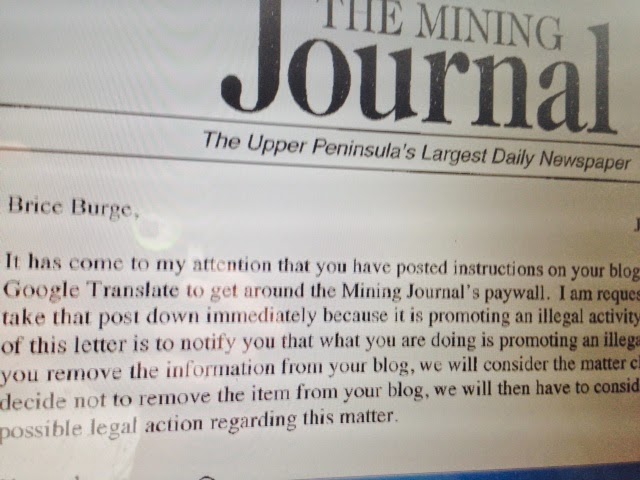David versus Goliath. New media versus old media. Marquette Social Scene versus the Mining Journal.
A classic battle is brewing here in Marquette. Or maybe it’s more of a skirmish.
In any case, it’s got the Mining Journal threatening to take some guerrilla journalists to court.
What started it all was the Mining Journal’s recent decision to erect a paywall on its website. If you want to get news online from the Mining Journal, you now have to pay for it.
Not all that unusual. Newspapers across the country are doing it. At a time when hard copy circulation is declining (and the Mining Journal concedes this), it’s a way to make money.
Well, Marquette Social Scene, a young, digital upstart that covers news, sports and entertainment, wasn’t thrilled with the new paywall. Brice Burge, the owner and editor of Marquette Social Scene, considers it a violation of public trust. He’s an idealist. He believes newspapers should be available to everybody so that we can be enlightened about the world around us.
So…(and this is where the skirmish started)…Burge re-published in Marquette Social Scene a posting from a reader on the Mining Journal’s Facebook page that told other readers how to work around the paywall.
Talk about irony. The newspaper’s own Facebook page was telling readers how to get the news product for free.
When Burge re-published the posting, the Mining Journal wasn’t pleased. Publisher Jim Reevs sent Burge a cease-and-desist order, claiming that he was promoting an illegal activity, and threatening legal action if the posting wasn’t taken down.
So far Burge isn’t budging.
One thing seems eminently clear. The Mining Journal needs to start monitoring its own Facebook page more carefully. Its failure to do so is what created the problem.
Second and more important is this. The new, hyperlocal, digital media–Marquette Social Scene, UP Second Wave, Marquette Magazine, Marquette Music Scene and Word on the Street–are here to stay. Some will die, some will grow, many will evolve, but as a means of gathering and distributing the news, they will play an increasingly vital role in our lives.
And the dinosaurs–the Mining Journal and the TV stations–will have to adapt (with more robust websites and social media involvement) or die. Cease-and-desist orders can only delay the inevitable.
———————————————–
Speaking of TV stations, the latest Nielsen ratings are out, and they spell good news for TV6. The longtime news leader here reasserted its overwhelming dominance at 6 pm after a serious drop in ratings last May.
The 11 pm ratings, which depend more heavily on the prime time offerings of the networks, were a little more competitive, with the new WJMN newscast posting decent numbers, but TV6 is still the unquestioned leader.
WJMN debuted its UP newscasts just a couple of months ago. It’ll take some time for the station to become truly relevant. You don’t overcome 50 years of dominance in just a ratings book or two.
As for ABC10, it keeps plugging along. Underfunded and underresourced, it produces solid newscasts at 5:30 and 10 pm and a substantive website with continual social media interaction. One of the station’s most obvious flaws, a news set that looks like it was hastily assembled in someone’s back office, will soon thankfully be history. The station is getting a new “virtual” set within a couple of months.
What does “virtual” mean? It means it’ll look like things are there on the set when they really aren’t. Electronic tricks. Slick. Sportscenter on ESPN employs a virtual set.
Also in from ABC 10: Al Jazeera America has requested that the station send them a long form story on the Bobby Glenn Brown story. Brown, of course, is the local man who recently took part in a commitment ceremony with his longtime partner, and was subsequently told by St. Michaels Catholic Church he could no longer take part in the ministry of the church.
The story’s gotten some national play. Now Al Jazeera America wants to do something with it.
————————————————-
If you’ve been wondering what’s going to happen at the site of the old Food Co-op, here’s a partial answer.
GEI Consultants, a nationwide engineering firm that’s currently located on Washington Street, is taking over half of the downstairs space and all of the upstairs space.
Upstairs will house the GEI offices while the downstairs is set aside for a soils and materials lab. A wall has already been erected downstairs, splitting the space. No word yet on who may move into the other half.
GEI works with the mines, government agencies and businesses. They employ 15 people here. The employees should be moving in to their new digs on about July 10th.
—————————————————–
The Marquette Farmers Market has been kind to the St. Charles Winery.
Marquette’s only winery moved into the Farmers Market for the first time this season, and sales are already up 30%.
In fact, owner Randy St. Charles says he and his wife Lisa are struggling to keep up with the sudden surge in demand. Production has more than doubled since they took over the winery nine months ago.
They offer between 20 and 30 wines–like watermelon and mandarin orange as well as the more traditional chardonnay and pinot noir–at prices ranging from $13 to $25 a bottle.
Of course, the grapes don’t come from the UP. They arrive in concentrate form from Central California and then they’re processed, with Lake Superior water and flavoring, by St. Charles at his shop on Washington Street.
It’s in a second floor office, next to an insurance agency, across the street from McDonalds. Not exactly the lush, rolling hills of Napa Valley.
But they have a wine-tasting room on site where they welcome individual wine enthusiasts and host small events and parties.
It’s a start. And it’s classic UP, devoid of pretension and driven by energy and enthusiasm.
You got news? Email me at briancabell@gmail.com









